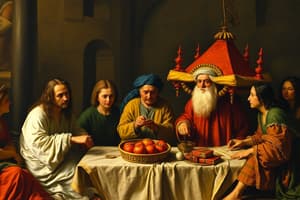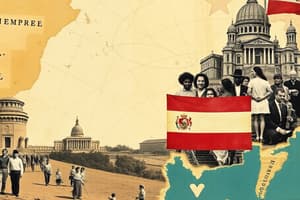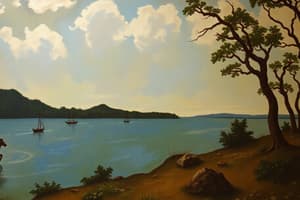Podcast
Questions and Answers
Which empires were dominant in the 15th century?
Which empires were dominant in the 15th century?
- Spanish Empire
- Ottoman Empire
- Mughal Empire
- All of the above (correct)
The Ottomans were intolerant towards other religions.
The Ottomans were intolerant towards other religions.
False (B)
What was the primary religion of the Mughal Empire?
What was the primary religion of the Mughal Empire?
Islam
Who was the Chinese admiral known for maritime exploration during the Ming Dynasty?
Who was the Chinese admiral known for maritime exploration during the Ming Dynasty?
The city of ______ was renowned for its wealth and education in west Africa.
The city of ______ was renowned for its wealth and education in west Africa.
What system caused the decline of the indigenous population in the Americas?
What system caused the decline of the indigenous population in the Americas?
What was a significant outcome of the Columbian Exchange?
What was a significant outcome of the Columbian Exchange?
Match the following social groups in Spanish America with their descriptions:
Match the following social groups in Spanish America with their descriptions:
Flashcards are hidden until you start studying
Study Notes
15th Century Empires Overview
- Major empires during the 15th century included the Spanish, Portuguese, Ottoman, Mughal, and Ming.
- The Columbian Exchange connected the "Old World" and "New World" through explorations by figures like Christopher Columbus.
- The social hierarchy in Spanish colonies was shaped by European power structures and the dynamics of global exchange.
Ottoman Empire
- Centered in modern-day Turkey, expanded rapidly, conquering Constantinople in 1453.
- Controlled much of southeastern Europe, the Middle East, and North Africa while practicing religious tolerance through the millet system.
- Taxed non-Muslims and maintained direct rule over subjects.
- Ottoman conquest of Byzantine Empire spurred European exploration for new trade routes to Asia.
Mughal Empire
- Located in the Indian Subcontinent, required tolerance towards the predominantly Hindu population.
- Implemented semi-autonomous governance for Hindus, granting some positions in government.
Ming Dynasty
- Ruled China from 1368 to 1644, known for cultural, economic, and technological growth.
- Actively engaged in maritime exploration with notable voyages by Admiral Zheng He in the Indian Ocean.
- Thrived on trade, specializing in valuable commodities like silk and porcelain.
African Empires of Mali and Songhai
- Positioned in West Africa as leaders of trade, wealth, and education.
- Timbuktu recognized for its organized structure, impressive library, and wealth from gold, salt, and slave trading.
Spanish Empire
- Formed from the unification of the crowns of Aragon and Castile, emerging as a dominant power in Europe.
- Early sponsor of exploration, notably Christopher Columbus, leading to Caribbean and American colonization.
- Spanish colonization resulted in a sharp decline of indigenous populations due to forced labor systems and diseases.
Portuguese Empire
- Key player in the Age of Exploration, creating colonies in Africa, Asia, and South America.
- Dominated the spice trade in the Indian Ocean, contributing to Portugal's wealth and influence.
The Columbian Exchange
- Refers to the significant interchange of crops, animals, culture, and populations between the Eastern and Western hemispheres post-Columbus.
- Introduced new crops like corn, potatoes, and tomatoes to Europe.
- Facilitated the spread of diseases such as smallpox and measles, which devastated indigenous populations in the Americas.
Social Hierarchy in Spanish America
- Spanish Peninsulares were at the top, including colonial administrators and Catholic clergy, forming the elite ruling class.
- Creoles, individuals of Spanish descent born in the colonies, occupied the next tier.
- Followed by Mestizos (mixed Spanish and indigenous descent) and Mulattos (mixed African and indigenous descent).
- Indigenous people who survived diseases and conquests were known as Indios, positioned near the bottom.
- African slaves comprised the lowest tier, primarily brought for labor in plantations and mines.
- The hierarchical structure enforced Spanish control and racial divisions, alongside efforts to impose Spanish culture through religious conversion and language laws.
Studying That Suits You
Use AI to generate personalized quizzes and flashcards to suit your learning preferences.




